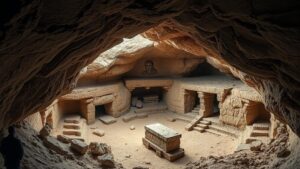Searching for the elusive Mokele-Mbembe in the swamps of the Congo Basin, rumored to resemble a living dinosaur.
Searching for the Elusive Mokele-Mbembe in the Congo Basin
The Mokele-Mbembe, often referred to as the river blocker, is a legendary creature said to inhabit the swamps and rivers of the Congo Basin. Described as resembling a sauropod dinosaur, this elusive beast has intrigued cryptozoologists, researchers, and adventurers alike. Let us embark on a comprehensive exploration of this fascinating topic, tracing the origins of the legend, examining the evidence, and assessing the current state of search efforts.
The Origins of the Legend
The lore of Mokele-Mbembe dates back to the indigenous populations of the Congo Basin, particularly the Mbenga and Bantu tribes. Reports of the creature have surfaced periodically since the late nineteenth century, with notable Western exploration accounts emerging in the early 1900s. In 1910, a Belgian missionary named Father rRbert C. W. L. became one of the first outsiders to write about the creature after hearing tales from local tribes.
Descriptions of Mokele-Mbembe vary, yet they often include features reminiscent of long-necked dinosaurs like the Brachiosaurus or Diplodocus. Typically, it is said to be a large, grayish animal, measuring up to 30 feet in length, with a long neck, a thick body, and a small head atop the neck. Some reports also mention a long tail and the power to capsize canoes, further contributing to its fearsome reputation.
Real-World Sightings and Evidence
Despite the captivating stories, tangible evidence of Mokele-Mbembe remains elusive. But, there have been sporadic sightings and anecdotal claims over the years. In 1980, a scientific expedition led by the renowned explorer Dr. Bernard Heuvelmans set off to investigate the creatures existence. While the expedition did not yield a confirmed sighting, it did highlight the biodiversity of the Congo River Basin, which includes numerous species yet to be documented.
More recent efforts, such as the 2009 expedition by filmmakers searching for the creature, also resulted in no concrete findings, but they documented the harsh and challenging environment that harbors countless undiscovered species.
Scientific Perspectives on Cryptozoology
From a scientific perspective, cryptozoology–the study of animals whose existence is unverified–often garners skepticism. While some species once deemed mythical, like the Okapi and the Komodo dragon, have been discovered, the scientific community requires substantial evidence before accepting the existence of a creature such as Mokele-Mbembe.
In a 2013 study published in The Journal of Cryptozoology, researchers attempted to correlate local ecological metrics with reported sightings but concluded that the evidence did not meet scientific standards for validation. The study emphasized the importance of rigor in analyzing claims around cryptid behavior and supported biologists calls for further exploration into the rich biodiversity of the Congo Basin, rather than pursuing mythical creatures alone.
The Challenges of the Landscape
The Congo Basin is one of the most biodiverse and ecologically complex regions on Earth, but it also presents significant obstacles to exploration and research. Dense rainforests, vast wetlands, and extensive flooding rivers create barriers that can deter even the most intrepid of explorers. For example:
- Environmental Conditions: The humidity, heat, and rainfall make it a challenging terrain for sustained human activities.
- Accessibility: Many parts of the basin can only be reached via canoe or by foot, increasing the difficulty of undertaking a search expedition.
- Health Concerns: Diseases such as malaria and yellow fever are prevalent, posing significant risks to those who venture into the region.
Future Prospects for Discovery
As technology continually advances, so too does the ability to explore and understand remote environments. Drones, satellite imaging, and genetic sampling provide researchers with new tools to study the enigmatic ecosystems of the Congo Basin more efficiently than ever before. Initiatives to map biodiversity could also uncover new species and provide insights into the conditions that might enable the persistence of legendary creatures like Mokele-Mbembe.
Actionable Takeaways
For those captivated by the legend of Mokele-Mbembe, here are some key points to consider:
- Research Sustainable Practices: Explore ways to engage with the Congo Basins ecosystems without contributing to environmental degradation.
- Support Local Conservation Efforts: Engage with organizations working to protect the regions rich biodiversity.
- Stay Informed: Follow developments in both scientific research and cryptozoological inquiries into mysterious creatures.
While the search for Mokele-Mbembe remains shrouded in mystery, the quest encapsulates a broader human fascination with the unknown. Whether the creature exists or not, the legends surrounding it serve as a reminder of the unexplored wonders of our natural world and the enduring enigma of its hidden inhabitants.



